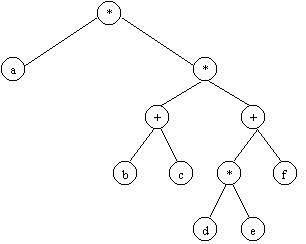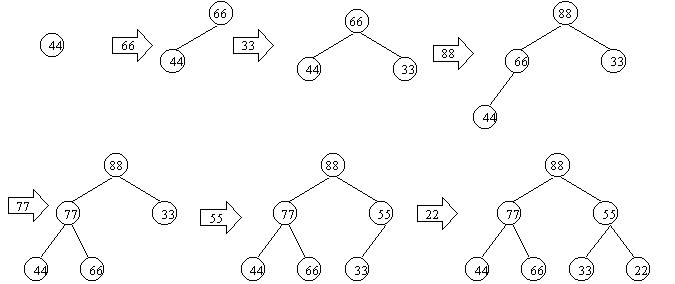public int binSearch(int[] A, int key) {
return binSearch(A, key, 0, A.length-1);
}
private int binSearch(int[] A, int key, int left, int right)
{
int midpoint=(left+right)/2; // find midpoint of interval left:right
if (left > right) // if the search interval is empty then
return -1; // return -1 to signal key not found
else
{
if (A[midpoint]==key)
return midpoint;
else if (key > A[midpoint])
return binSearch(A, key, midpoint+1, right);
else
return binSearch(A, key, left, midpoint-1);
}
}
public void reverse()
{
Queue q = new Queue();
while (!this.isEmpty()) {
q.insert(this.pop());
}
while (!q.isEmpty()) {
this.push((String)q.remove());
}
}
It's also possible to write reverse without using
a queue at all -- but just with the Stack class.
Can you do it?
- Not a heap. Parent 44 is not bigger than child 77
- Heap.
- Heap.
- Not a heap. Heaps must be complete.
- Heap.
- Not a heap. Parent 22 is not bigger than child 55
public void linearize()
{
if (length > 0) {
ListNode runner = firstNode;
while (runner.next != firstNode) {
runner = runner.next;
}
runner.next = null;
}
}
Note how this code handles both the 0-node and 1-node cases
correctly.
if the subtree rooted at N is an empty tree (base case)
then return 0 (since the answer is 0 for an empty tree)
else {
// it's the recursive case: a real node with two (possibly empty)
// trees dangling off of it
if the real node is a leaf (which means N is the root of a 1-node tree)
return 1 (since the answer is "1 leaf" for a 1-node tree)
else
// real node that N points to is not a leaf, so the answer is
// # of leaves in N's left subtree +
// # of leaves in N's right subtree
return (recursive call with N.llink) + (recursive call with N.rlink)
}
Now just translate to code:
// returns number of leaves in tree
public int leafCount()
{
return leafCount(root);
}
// # of leaves in the subtree rooted at N is equal to
// 0 if empty tree, 1 if N is a leaf, and if not a leaf,
// to the # of leaves in left subtree + # of leaves in right subtree
private int leafCount(BSTnode N)
{
if (N == null)
return 0;
else if (N.llink==null && N.rlink==null)
return 1;
else return leafCount(N.llink) + leafCount(N.rlink);
}
p(K) = 1
| index: | 0 | 1 | 2 | 3 | 4 | 5 | 6 | 7 | 8 | 9 | 10 |
| entry: | 66 | 54 | 62 | 73 | 19 | 32 |
p(K) = max(1,(K/11)%11)
| index: | 0 | 1 | 2 | 3 | 4 | 5 | 6 | 7 | 8 | 9 | 10 |
| entry: | 66 | 73 | 54 | 62 | 19 | 32 |
This is the expression tree for a*((b+c)*(d*e+f)).

This expression is different than the expression a*(b+c)*(d*e+f) because, without explicit parentheses, equivalent operations in infix expressions are assumed to be done in left-to-right order. Thus, the latter expression is equivalent to (a*(b+c))*(d*e+f) where we have explicitly stated that (b+c) should be multiplied by a first. The corresponding expression tree is:


Array versions. Arrays start at index 1:
Insert 44:
| 44 |
Insert 66:
| 66 | 44 |
Insert 33:
| 66 | 44 | 33 |
Insert 88:
| 88 | 66 | 33 | 44 |
Insert 77:
| 88 | 77 | 33 | 44 | 66 |
Insert 55:
| 88 | 77 | 55 | 44 | 66 | 33 |
Insert 22:
| 88 | 77 | 55 | 44 | 66 | 33 | 22 |